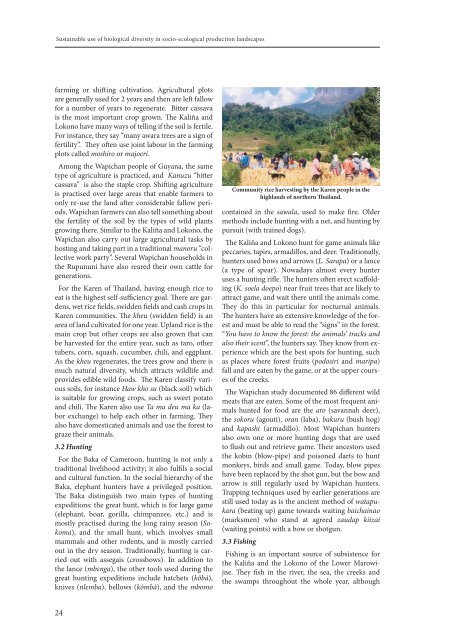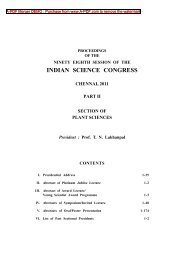sustainable use of biological diversity.pdf - India Environment Portal
sustainable use of biological diversity.pdf - India Environment Portal
sustainable use of biological diversity.pdf - India Environment Portal
Create successful ePaper yourself
Turn your PDF publications into a flip-book with our unique Google optimized e-Paper software.
Sustainable <strong>use</strong> <strong>of</strong> <strong>biological</strong> <strong>diversity</strong> in socio-ecological production landscapes<br />
farming or shifting cultivation. Agricultural plots<br />
are generally <strong>use</strong>d for 2 years and then are left fallow<br />
for a number <strong>of</strong> years to regenerate. Bitter cassava<br />
is the most important crop grown. The Kaliña and<br />
Lokono have many ways <strong>of</strong> telling if the soil is fertile.<br />
For instance, they say “many awara trees are a sign <strong>of</strong><br />
fertility”. They <strong>of</strong>ten <strong>use</strong> joint labour in the farming<br />
plots called moshiro or majoeri.<br />
Among the Wapichan people <strong>of</strong> Guyana, the same<br />
type <strong>of</strong> agriculture is practiced, and Kanuzu “bitter<br />
cassava” is also the staple crop. Shifting agriculture<br />
is practised over large areas that enable farmers to<br />
only re-<strong>use</strong> the land after considerable fallow periods.<br />
Wapichan farmers can also tell something about<br />
the fertility <strong>of</strong> the soil by the types <strong>of</strong> wild plants<br />
growing there. Similar to the Kaliña and Lokono, the<br />
Wapichan also carry out large agricultural tasks by<br />
hosting and taking part in a traditional manoru “collective<br />
work party”. Several Wapichan ho<strong>use</strong>holds in<br />
the Rupununi have also reared their own cattle for<br />
generations.<br />
For the Karen <strong>of</strong> Thailand, having enough rice to<br />
eat is the highest self-sufficiency goal. There are gardens,<br />
wet rice fields, swidden fields and cash crops in<br />
Karen communities. The kheu (swidden field) is an<br />
area <strong>of</strong> land cultivated for one year. Upland rice is the<br />
main crop but other crops are also grown that can<br />
be harvested for the entire year, such as taro, other<br />
tubers, corn, squash, cucumber, chili, and eggplant.<br />
As the kheu regenerates, the trees grow and there is<br />
much natural <strong>diversity</strong>, which attracts wildlife and<br />
provides edible wild foods. The Karen classify various<br />
soils, for instance Haw kho su (black soil) which<br />
is suitable for growing crops, such as sweet potato<br />
and chili. The Karen also <strong>use</strong> Ta ma deu ma ka (labor<br />
exchange) to help each other in farming. They<br />
also have domesticated animals and <strong>use</strong> the forest to<br />
graze their animals.<br />
3.2 Hunting<br />
For the Baka <strong>of</strong> Cameroon, hunting is not only a<br />
traditional livelihood activity; it also fulfils a social<br />
and cultural function. In the social hierarchy <strong>of</strong> the<br />
Baka, elephant hunters have a privileged position.<br />
The Baka distinguish two main types <strong>of</strong> hunting<br />
expeditions: the great hunt, which is for large game<br />
(elephant, boar, gorilla, chimpanzee, etc.) and is<br />
mostly practised during the long rainy season (Sokoma),<br />
and the small hunt, which involves small<br />
mammals and other rodents, and is mostly carried<br />
out in the dry season. Traditionally, hunting is carried<br />
out with assegais (crossbows). In addition to<br />
the lance (mbεnga), the other tools <strong>use</strong>d during the<br />
great hunting expeditions include hatchets (kôbà),<br />
knives (nlεmba), bellows (kômbà), and the mbomo<br />
community rice harvesting by the Karen people in the<br />
highlands <strong>of</strong> northern Thailand.<br />
contained in the sawala, <strong>use</strong>d to make fire. Older<br />
methods include hunting with a net, and hunting by<br />
pursuit (with trained dogs).<br />
The Kaliña and Lokono hunt for game animals like<br />
peccaries, tapirs, armadillos, and deer. Traditionally,<br />
hunters <strong>use</strong>d bows and arrows (L. Sarapa) or a lance<br />
(a type <strong>of</strong> spear). Nowadays almost every hunter<br />
<strong>use</strong>s a hunting rifle. The hunters <strong>of</strong>ten erect scaffolding<br />
(K. soela doepo) near fruit trees that are likely to<br />
attract game, and wait there until the animals come.<br />
They do this in particular for nocturnal animals.<br />
The hunters have an extensive knowledge <strong>of</strong> the forest<br />
and must be able to read the “signs” in the forest.<br />
“You have to know the forest: the animals’ tracks and<br />
also their scent”, the hunters say. They know from experience<br />
which are the best spots for hunting, such<br />
as places where forest fruits (podosiri and maripa)<br />
fall and are eaten by the game, or at the upper courses<br />
<strong>of</strong> the creeks.<br />
The Wapichan study documented 86 different wild<br />
meats that are eaten. Some <strong>of</strong> the most frequent animals<br />
hunted for food are the aro (savannah deer),<br />
the sokoru (agouti), oran (laba), bakuru (bush hog)<br />
and kapashi (armadillo). Most Wapichan hunters<br />
also own one or more hunting dogs that are <strong>use</strong>d<br />
to flush out and retrieve game. Their ancestors <strong>use</strong>d<br />
the kobin (blow-pipe) and poisoned darts to hunt<br />
monkeys, birds and small game. Today, blow pipes<br />
have been replaced by the shot gun, but the bow and<br />
arrow is still regularly <strong>use</strong>d by Wapichan hunters.<br />
Trapping techniques <strong>use</strong>d by earlier generations are<br />
still <strong>use</strong>d today as is the ancient method <strong>of</strong> watapukara<br />
(beating up) game towards waiting baichainao<br />
(marksmen) who stand at agreed zaudap kiizai<br />
(waiting points) with a bow or shotgun.<br />
3.3 Fishing<br />
Fishing is an important source <strong>of</strong> subsistence for<br />
the Kaliña and the Lokono <strong>of</strong> the Lower Marowijne.<br />
They fish in the river, the sea, the creeks and<br />
the swamps throughout the whole year, although<br />
© IMPECT<br />
24
















